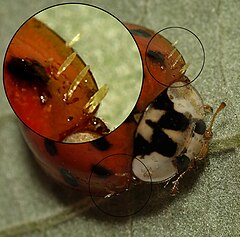Laboulbeniales
| Laboulbeniales | |
|---|---|
 |
|
| Laboulbeniales on Harmonia axyridis | |
| Scientific classification | |
| Kingdom: | Fungi |
| Division: | Ascomycota |
| Class: | Laboulbeniomycetes |
| Order: |
Laboulbeniales Engler (1898) |
| Families | |
|
Ceratomycetaceae |
|
Ceratomycetaceae
Euceratomycetaceae
Herpomycetaceae
Laboulbeniaceae
The Laboulbeniales is an order of Fungi within the class Laboulbeniomycetes. They are also known by the colloquial name, labouls. The labouls include over 2000 species of obligate insect ectoparasites, with cellular thalli. They typically do not kill their hosts, although they may impair host fitness if the level of infestation is high.
Laboulbeniales form individual thalli, and lack vegetative hyphae. A thallus is attached to its host by a dark-colored foot cell, through which the fungus penetrates the exoskeleton of its host to draw nutrition from the hemolymph. The external part of the thallus may form male structures (antheridia) or female structures (trichogynes and perithecia), or both. New infections are initiated when spores from the perithecia attach to a compatible insect host. Spore transmission can sometimes occur during insect copulation, which may account for the different site specificity sometimes observed in male and female hosts. These fungi do not grow apart from their hosts.
Foundational work on the Laboulbeniales was completed by the American mycologist Roland Thaxter (1858–1932), particularly in a five-volume illustrated series (1896–1931).
...
Wikipedia
